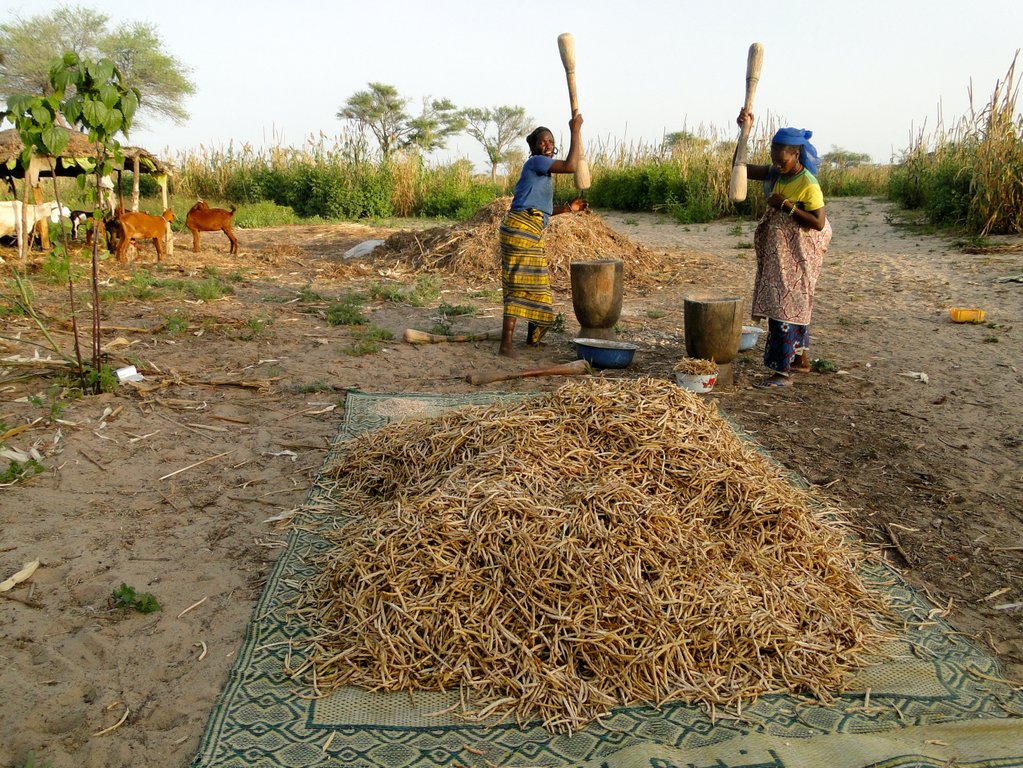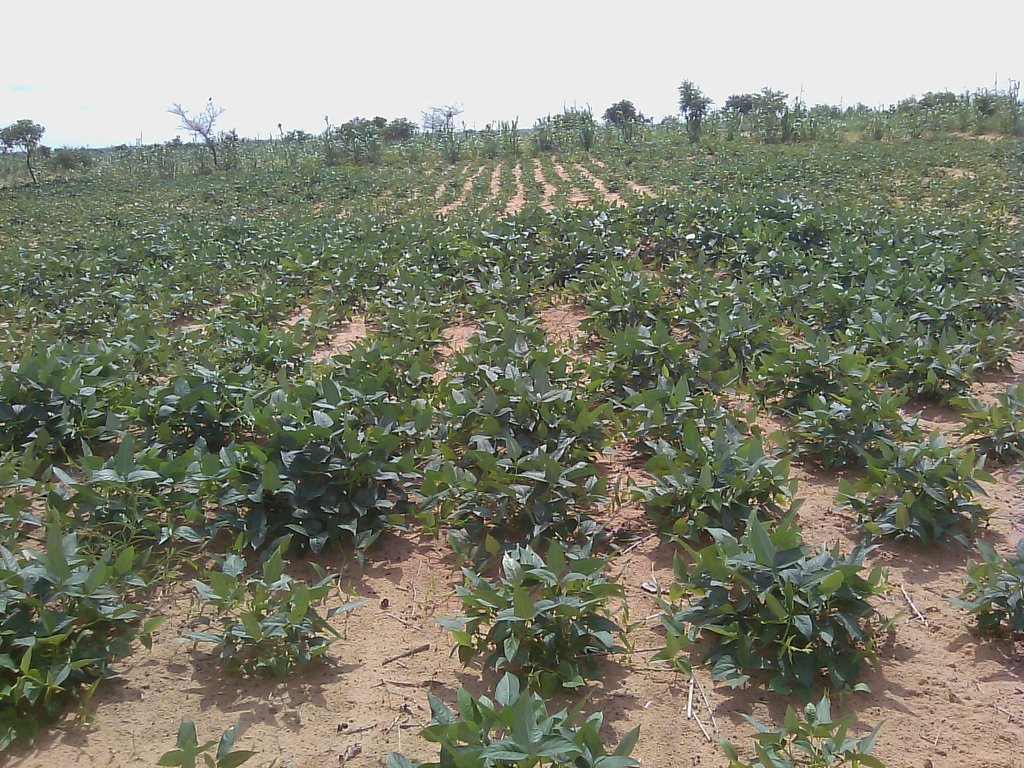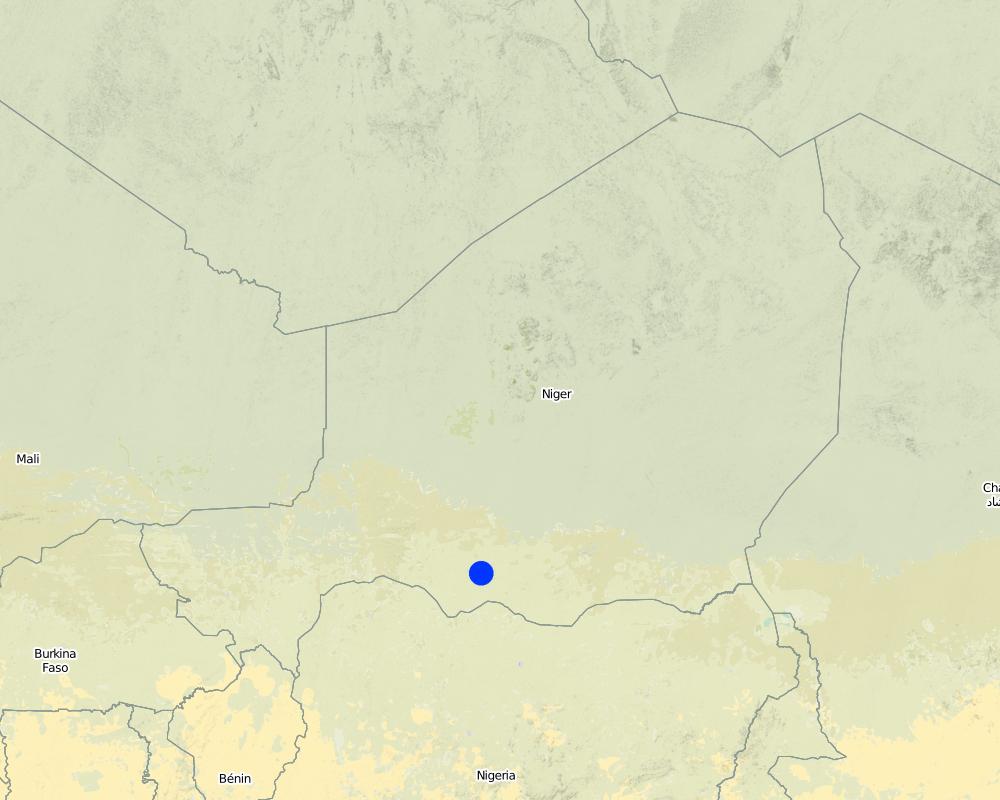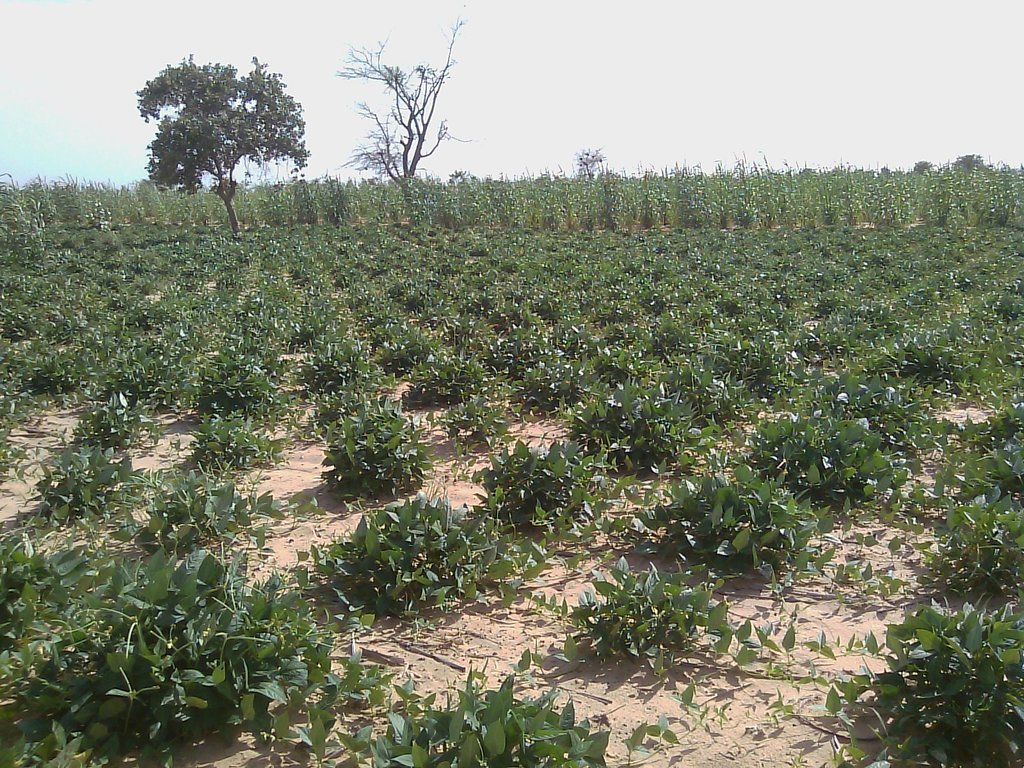Improved cowpea variety (IT90k372-1-2) [Niger]
- Creation:
- Update:
- Compiler: Judith Macchi
- Editors: Christine Lottje, Rabé Mahamane Moctar
- Reviewers: Christine Lottje, David Beritault, Alexandra Gavilano
Waké mai jan hanci
technologies_663 - Niger
View sections
Expand all Collapse all1. General information
1.2 Contact details of resource persons and institutions involved in the assessment and documentation of the Technology
Name of project which facilitated the documentation/ evaluation of the Technology (if relevant)
Book project: where people and their land are safer - A Compendium of Good Practices in Disaster Risk Reduction (DRR) (where people and their land are safer)Name of the institution(s) which facilitated the documentation/ evaluation of the Technology (if relevant)
HEKS (Hilfswerk der Evangelischen Kirchen Schweiz) (HEKS (Hilfswerk der Evangelischen Kirchen Schweiz)) - Switzerland1.3 Conditions regarding the use of data documented through WOCAT
When were the data compiled (in the field)?
12/10/2016
The compiler and key resource person(s) accept the conditions regarding the use of data documented through WOCAT:
Yes
1.4 Declaration on sustainability of the described Technology
Is the Technology described here problematic with regard to land degradation, so that it cannot be declared a sustainable land management technology?
No
1.5 Reference to Questionnaire(s) on SLM Approaches
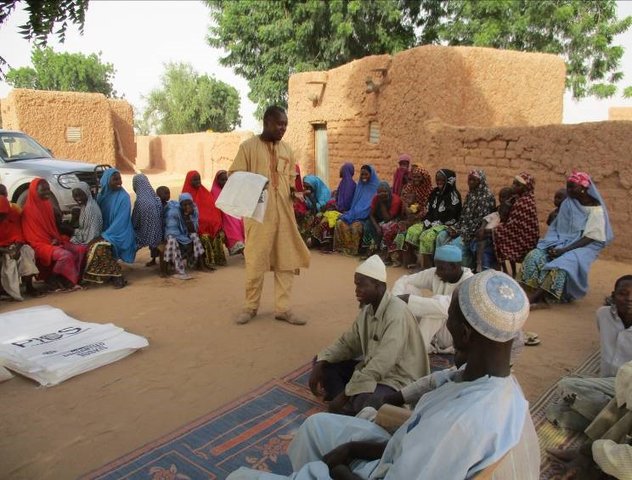
Training and awareness raising in the use of … [Niger]
This approach consists of disseminating improved agricultural techniques to increase the agricultural production. Producers are trained to demonstrate the techniques, and demonstration events are organised to make other producers aware of the use of these improved techniques.
- Compiler: Judith Macchi
2. Description of the SLM Technology
2.1 Short description of the Technology
Definition of the Technology:
The improved cowpea variety (IT90k372-1-2) has a short cycle, multiple resistance and is adapted to the tropical agro-ecological zone.
2.2 Detailed description of the Technology
Description:
As in all of Niger, the department of Mayahi in the southern central part of the country is characterized by a harsh natural environment with low precipitation, which is variable in space and time, and high temperatures, with a tendency to increase even more due to the effects of climate change, increasing the aridity of the region. With 3,1%, the population is growth is very high. The pressure on the natural resources has also strongly increased, and the chronic food insecurity regularly affects the majority of the population.
Millet and cowpea are the main agricultural products of the region, but due to the demographic pressure, the arable land is practically entirely in use. Consequently, food security can only be achieved through an increased production.
The cowpea variety IT90K-372-1-2 is of an inbred line nature and was developed in 1990 by the International Institute of Tropical Agriculture (IIAT) based in Ibadan in Nigeria. It has a growth cycle of 60 to 70 days with a semi-erect bearing and a spread bloom. The potential yield of IT90K-372-1-2 is 1.2 to 1.5 tonnes per ha. The grains are white-coloured with a red-coloured eye. This variety is resistant to drought (isohyet 300-600 mm), tolerant to aphids, but sensitive to striga, thrips and beetles. It grows as well on fertile land as on degraded land. Its growth cycle is well adapted to the rainfall, especially in regions with a chronic rainfall deficit. Through its capacity for symbiotic nitrogen fixation, integrating cowpea in the crop rotation enables to fulfill the requirements for nitrogen fertiliser of the subsequent crops (Bationo et al., 1990). This variety was registered in the catalog of improved varieties of Niger in 2010 by the National Agronomic Research Institute of Niger (INRAN).
The recommended period for seeding are the first fifteen days in the month of July. The field should be well ploughed to promote the root development. In the zones with more fragile zones prone to erosion, it is recommended to adopt minimum tillage or no-tillage. Three grains must be sown in each pocket, and thinned out to two plants per stem two weeks after seeding. The latter is done in a pit of 2,5 to 5 cm depth in the soil ridges, or in the surface, depending on the type of soil preparation. Approximately 20 kg/ha of grains of IT90K-372-1-2 are used with a spacing of 75 cm x 20 cm. This variety does not require so much nitrogen fertiliser because, like any variety of cowpea, it fixes nitrogen from the atmosphere by the nodules contained between its roots. Nevertheless it is essential to apply it in small quantities (around 15 kg/ha of nitrogen) when starting on poor soils. A nitrogen excess leads to a low grain production and a strong vegetative growth. Around 30 kg of P/ha is recommended in the form of Supa for the production of cowpea in order to support the crop to nodulate to fix atmospheric nitrogen. Weeding with a hoe is the most frequently used method by the farmers; it is done for a first time two weeks after seeding and a second time 4-5 weeks after seeding to keep the field clean of weed.
Cowpea contributes for a substantial part to meeting the food requirements of the population in tropical countries (Bressani 1997). The variety IT90K372-1-2 is appreciated by the producers because of the size of its grains (large), the colour of the grains (white) and the taste.
2.3 Photos of the Technology
2.5 Country/ region/ locations where the Technology has been applied and which are covered by this assessment
Country:
Niger
Region/ State/ Province:
Maradi
Further specification of location:
Mayahi
Map
×2.6 Date of implementation
Indicate year of implementation:
2014
2.7 Introduction of the Technology
Specify how the Technology was introduced:
- during experiments/ research
- through projects/ external interventions
Comments (type of project, etc.):
This is a research and development project coordinated by a teacher-researcher.
3. Classification of the SLM Technology
3.1 Main purpose(s) of the Technology
- improve production
- reduce, prevent, restore land degradation
- adapt to climate change/ extremes and its impacts
- create beneficial economic impact
3.2 Current land use type(s) where the Technology is applied

Cropland
- Annual cropping
Main crops (cash and food crops):
millet, sorghum, cowpea, groundnut
3.3 Further information about land use
Water supply for the land on which the Technology is applied:
- rainfed
Number of growing seasons per year:
- 1
3.4 SLM group to which the Technology belongs
- integrated soil fertility management
- integrated pest and disease management (incl. organic agriculture)
- improved plant varieties/ animal breeds
3.5 Spread of the Technology
Specify the spread of the Technology:
- evenly spread over an area
If the Technology is evenly spread over an area, indicate approximate area covered:
- 0.1-1 km2
Comments:
The technology was brought to 20 villages with 8 farmers per village and 0.5 ha per producer.
3.6 SLM measures comprising the Technology

agronomic measures
- A2: Organic matter/ soil fertility
- A5: Seed management, improved varieties
3.7 Main types of land degradation addressed by the Technology

chemical soil deterioration
- Cn: fertility decline and reduced organic matter content (not caused by erosion)
Comments:
Through its capacity for symbiotic nitrogen fixation, integrating cowpea in the crop rotation enables to fulfill the requirements for nitrogen fertiliser of the subsequent crops (Bationo et al., 1990).
3.8 Prevention, reduction, or restoration of land degradation
Specify the goal of the Technology with regard to land degradation:
- reduce land degradation
- restore/ rehabilitate severely degraded land
4. Technical specifications, implementation activities, inputs, and costs
4.1 Technical drawing of the Technology
4.2 Technical specifications/ explanations of technical drawing
This is a semi-erect variety with a spacing of 0.7 m between the lines and 0.5 m between the pockets, or a density of 28.000 pockets/hectare. The seed quantity for sowing one hectare is 20 kg. The growth cycle is 60 to 70 days with a potential yield of 1.2 to 1.5 tonnes/hectare.
4.3 General information regarding the calculation of inputs and costs
Specify how costs and inputs were calculated:
- per Technology area
Indicate size and area unit:
the unit of the area is hectare (ha)
other/ national currency (specify):
CFA franc
Indicate exchange rate from USD to local currency (if relevant): 1 USD =:
617.0
Indicate average wage cost of hired labour per day:
1250 CFA francs per person-day
4.4 Establishment activities
| Activity | Type of measure | Timing | |
|---|---|---|---|
| 1. | Soil preparation | Agronomic | May |
| 2. | Seedbed | Agronomic | July |
| 3. | Maintenance | Agronomic | July |
| 4. | Phytosanitary treatment (neem seed) | Agronomic | August |
| 5. | Harvest | Agronomic | September |
| 6. | Stocking | Management | October |
4.5 Costs and inputs needed for establishment
| Specify input | Unit | Quantity | Costs per Unit | Total costs per input | % of costs borne by land users | |
|---|---|---|---|---|---|---|
| Labour | from sowing to harvest | person-days | 20.0 | 1250.0 | 25000.0 | 100.0 |
| Plant material | seed | kg | 15.0 | 500.0 | 7500.0 | |
| Fertilizers and biocides | organic manure | cart | 40.0 | 200.0 | 8000.0 | 100.0 |
| Fertilizers and biocides | fungicide | bag | 1.0 | 500.0 | 500.0 | 100.0 |
| Fertilizers and biocides | fertiliser | kg | 75.0 | 300.0 | 22500.0 | 100.0 |
| Total costs for establishment of the Technology | 63500.0 | |||||
If land user bore less than 100% of costs, indicate who covered the remaining costs:
The project has financed the cost of seed and the management.
4.6 Maintenance/ recurrent activities
| Activity | Type of measure | Timing/ frequency | |
|---|---|---|---|
| 1. | Soil preparation | Agronomic | May |
| 2. | Seedbed | Agronomic | July |
| 3. | Maintenance | Agronomic | July |
| 4. | Phytosanitary treatment (neem seed) | Agronomic | August |
| 5. | Harvest | Agronomic | September |
| 6. | Stocking | Management | October |
4.7 Costs and inputs needed for maintenance/ recurrent activities (per year)
| Specify input | Unit | Quantity | Costs per Unit | Total costs per input | % of costs borne by land users | |
|---|---|---|---|---|---|---|
| Labour | from sowing to harvest | person-days | 20.0 | 1250.0 | 25000.0 | 100.0 |
| Plant material | seed | kg | 15.0 | 500.0 | 7500.0 | |
| Fertilizers and biocides | organic manure | cart | 40.0 | 200.0 | 8000.0 | 100.0 |
| Fertilizers and biocides | fungicide | bag | 1.0 | 500.0 | 500.0 | 100.0 |
| Fertilizers and biocides | fertiliser | kg | 75.0 | 300.0 | 22500.0 | 100.0 |
| Total costs for maintenance of the Technology | 63500.0 | |||||
4.8 Most important factors affecting the costs
Describe the most determinate factors affecting the costs:
The cost of the technology is most influenced by the chemical fertiliser.
5. Natural and human environment
5.1 Climate
Annual rainfall
- < 250 mm
- 251-500 mm
- 501-750 mm
- 751-1,000 mm
- 1,001-1,500 mm
- 1,501-2,000 mm
- 2,001-3,000 mm
- 3,001-4,000 mm
- > 4,000 mm
Specify average annual rainfall (if known), in mm:
250.00
Specifications/ comments on rainfall:
Rainy season from July to September.
Indicate the name of the reference meteorological station considered:
Mayahi
Agro-climatic zone
- semi-arid
5.2 Topography
Slopes on average:
- flat (0-2%)
- gentle (3-5%)
- moderate (6-10%)
- rolling (11-15%)
- hilly (16-30%)
- steep (31-60%)
- very steep (>60%)
Landforms:
- plateau/plains
- ridges
- mountain slopes
- hill slopes
- footslopes
- valley floors
Altitudinal zone:
- 0-100 m a.s.l.
- 101-500 m a.s.l.
- 501-1,000 m a.s.l.
- 1,001-1,500 m a.s.l.
- 1,501-2,000 m a.s.l.
- 2,001-2,500 m a.s.l.
- 2,501-3,000 m a.s.l.
- 3,001-4,000 m a.s.l.
- > 4,000 m a.s.l.
Indicate if the Technology is specifically applied in:
- not relevant
5.3 Soils
Soil depth on average:
- very shallow (0-20 cm)
- shallow (21-50 cm)
- moderately deep (51-80 cm)
- deep (81-120 cm)
- very deep (> 120 cm)
Soil texture (topsoil):
- coarse/ light (sandy)
Soil texture (> 20 cm below surface):
- coarse/ light (sandy)
Topsoil organic matter:
- low (<1%)
If available, attach full soil description or specify the available information, e.g. soil type, soil PH/ acidity, Cation Exchange Capacity, nitrogen, salinity etc.
The groundwater table is at more than 50 m depth.
5.4 Water availability and quality
Ground water table:
> 50 m
Availability of surface water:
poor/ none
Water quality (untreated):
poor drinking water (treatment required)
Is water salinity a problem?
No
Is flooding of the area occurring?
No
5.5 Biodiversity
Species diversity:
- low
Habitat diversity:
- low
5.6 Characteristics of land users applying the Technology
Sedentary or nomadic:
- Sedentary
Market orientation of production system:
- mixed (subsistence/ commercial
Off-farm income:
- less than 10% of all income
Relative level of wealth:
- very poor
Individuals or groups:
- individual/ household
Level of mechanization:
- manual work
Gender:
- women
- men
Age of land users:
- youth
- middle-aged
Indicate other relevant characteristics of the land users:
The heads of the agricultural enterprises are on average 48 years old (+- 12 years). Land is predominantly acquired through inheritance and purchase. Renting, chopping right, donation and subtenancy are less frequent. Cereals are firstly intended for own consumption, and the residues (straw and stubble) are kept for the animals.
5.7 Average area of land owned or leased by land users applying the Technology
- < 0.5 ha
- 0.5-1 ha
- 1-2 ha
- 2-5 ha
- 5-15 ha
- 15-50 ha
- 50-100 ha
- 100-500 ha
- 500-1,000 ha
- 1,000-10,000 ha
- > 10,000 ha
Is this considered small-, medium- or large-scale (referring to local context)?
- small-scale
5.8 Land ownership, land use rights, and water use rights
Land ownership:
- individual, not titled
Land use rights:
- individual
Water use rights:
- communal (organized)
5.9 Access to services and infrastructure
health:
- poor
- moderate
- good
education:
- poor
- moderate
- good
technical assistance:
- poor
- moderate
- good
employment (e.g. off-farm):
- poor
- moderate
- good
markets:
- poor
- moderate
- good
energy:
- poor
- moderate
- good
roads and transport:
- poor
- moderate
- good
drinking water and sanitation:
- poor
- moderate
- good
financial services:
- poor
- moderate
- good
6. Impacts and concluding statements
6.1 On-site impacts the Technology has shown
Socio-economic impacts
Production
crop production
Quantity before SLM:
108 kg
Quantity after SLM:
606 kg
Comments/ specify:
The agricultural production is multiplied by 5.6.
Income and costs
expenses on agricultural inputs
Comments/ specify:
Improved seed (1,000 CFA francs/kg) is more expensive than local seed (500 CFA francs/kg).
farm income
Quantity before SLM:
43,200 CFA francs on average
Quantity after SLM:
240,000 CFA francs on average
Comments/ specify:
The farm income is multiplied by 5.5.
Socio-cultural impacts
food security/ self-sufficiency
Ecological impacts
Climate and disaster risk reduction
drought impacts
6.3 Exposure and sensitivity of the Technology to gradual climate change and climate-related extremes/ disasters (as perceived by land users)
Gradual climate change
Gradual climate change
| Season | Type of climatic change/ extreme | How does the Technology cope with it? | |
|---|---|---|---|
| seasonal temperature | dry season | increase | well |
| other gradual climate change | variability of rainfall (increase of extreme precipitation, anomalies between the seasons) | increase | well |
Climate-related extremes (disasters)
Climatological disasters
| How does the Technology cope with it? | |
|---|---|
| drought | well |
6.4 Cost-benefit analysis
How do the benefits compare with the establishment costs (from land users’ perspective)?
Short-term returns:
positive
Long-term returns:
positive
How do the benefits compare with the maintenance/ recurrent costs (from land users' perspective)?
Short-term returns:
positive
Long-term returns:
positive
6.5 Adoption of the Technology
- 10-50%
Of all those who have adopted the Technology, how many have did so spontaneously, i.e. without receiving any material incentives/ payments?
- 10-50%
6.6 Adaptation
Has the Technology been modified recently to adapt to changing conditions?
No
6.7 Strengths/ advantages/ opportunities of the Technology
| Strengths/ advantages/ opportunities in the land user’s view |
|---|
|
Productivity |
| The short cycle of the technology |
| Resistance to multiple factors (drought, aphid) |
| Food security |
| Strengths/ advantages/ opportunities in the compiler’s or other key resource person’s view |
|---|
| Earliness |
| Resistance to pests |
| Increased yield |
| Tolerance to low soil fertility |
6.8 Weaknesses/ disadvantages/ risks of the Technology and ways of overcoming them
| Weaknesses/ disadvantages/ risks in the land user’s view | How can they be overcome? |
|---|---|
| Cost of seed |
Support from NGOs and projects |
| Sensitive to striga | Weeding |
| Monitoring requirements |
| Weaknesses/ disadvantages/ risks in the compiler’s or other key resource person’s view | How can they be overcome? |
|---|---|
| Cost of inputs (fertiliser and seed) | Subsidies on inputs from the government |
7. References and links
7.1 Methods/ sources of information
- field visits, field surveys
10
- interviews with land users
10
- interviews with SLM specialists/ experts
3
- compilation from reports and other existing documentation
2
7.2 References to available publications
Title, author, year, ISBN:
Magah I.M., (s.d) La culture du niébé au Sahel. INRAN / Niger, 5 p.
Links and modules
Expand all Collapse allLinks

Training and awareness raising in the use of … [Niger]
This approach consists of disseminating improved agricultural techniques to increase the agricultural production. Producers are trained to demonstrate the techniques, and demonstration events are organised to make other producers aware of the use of these improved techniques.
- Compiler: Judith Macchi
Modules
No modules



